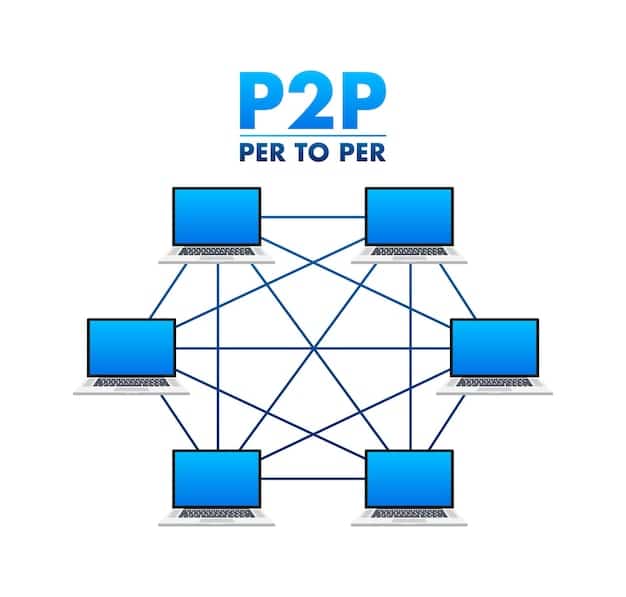Cybersecurity Guide: Data Encryption for Ultimate Security in 2025

Data encryption is a crucial cybersecurity measure for securing sensitive information in 2025, involving encoding data to prevent unauthorized access and maintain confidentiality, integrity, and availability.
In today’s digital world, protecting sensitive information is more critical than ever. This Cybersecurity Guide: The Ultimate Guide to Data Encryption: Securing Sensitive Information in 2025 will provide you with the essential knowledge and tools to safeguard your data effectively.
Understanding Data Encryption Fundamentals
Data encryption is the process of converting readable data into an unreadable format, known as ciphertext. This ensures that only authorized parties with the correct decryption key can access the original information. Understanding its fundamentals is key to implementing robust security measures.
What is Encryption?
Encryption is a security technique that transforms data into an unreadable format to protect it from unauthorized access. This involves using cryptographic algorithms and keys to encode and decode information, ensuring confidentiality and integrity.
Why is Encryption Important?
Encryption is vital for securing data whether it is at rest or in transit, protecting sensitive information from potential breaches. It provides a layer of security that helps maintain compliance with data protection regulations and builds trust with customers and stakeholders.
- Confidentiality: Encryption ensures that sensitive data remains confidential, accessible only to authorized users.
- Integrity: Encryption helps maintain data integrity by detecting any unauthorized alterations.
- Compliance: Encryption is often required by laws and regulations, such as HIPAA and GDPR.
- Trust: Implementing strong encryption practices builds trust with customers and partners.
In conclusion, data encryption is a fundamental security practice. By understanding these components, businesses and individuals can better protect their sensitive data from unauthorized access and breaches.
Types of Encryption Algorithms
Encryption algorithms are the mathematical formulas used to encrypt and decrypt data. Different algorithms offer varying levels of security and performance. Understanding the types of algorithms is essential for making informed decisions about data protection.

There are two main categories of encryption algorithms: symmetric and asymmetric. Symmetric encryption uses the same key for both encryption and decryption, while asymmetric encryption uses a pair of keys – a public key for encryption and a private key for decryption.
Symmetric Encryption
Symmetric encryption algorithms are known for their speed and efficiency. They are suitable for encrypting large amounts of data where performance is critical. The Advanced Encryption Standard (AES) is a widely used symmetric algorithm.
Asymmetric Encryption
Asymmetric encryption algorithms, such as RSA, provide enhanced security through the use of key pairs. While slower than symmetric encryption, they are essential for secure key exchange and digital signatures.
- AES (Advanced Encryption Standard): A widely used symmetric encryption algorithm known for its speed and security.
- RSA (Rivest-Shamir-Adleman): A popular asymmetric encryption algorithm used for secure data transmission and digital signatures.
- Triple DES (3DES): An older symmetric encryption algorithm that applies the DES algorithm three times to each data block.
- ECC (Elliptic Curve Cryptography): An asymmetric encryption algorithm that provides strong security with smaller key sizes.
Selecting the appropriate encryption algorithm depends on the specific security requirements and performance considerations of the application. Each algorithm offers strengths and weaknesses that should be carefully evaluated.
Implementing Encryption: Best Practices
Proper implementation of encryption is critical for ensuring data security. Following best practices can help organizations effectively protect their sensitive information and mitigate potential risks. Start by assessing encryption needs and establish clear policies and procedures.
Secure key management is vital to the success of any encryption strategy. Keys should be securely stored, regularly rotated, and access should be strictly controlled. Strong keys are fundamental to the strength of the encryption.
Key Management
Effective key management practices include generating strong keys, storing keys securely, and implementing access controls to prevent unauthorized use. Key rotation is a critical aspect of key management to minimize the impact of potential key compromise. Regularly rotating keys can significantly enhance the security of encrypted data.
Encryption for Data at Rest
Data at rest refers to data stored on devices or in databases. Encrypting data at rest ensures that even if a device is lost or stolen, the data remains protected. Full disk encryption and database encryption are common methods for securing data at rest.
Encryption is a critical component of modern cybersecurity strategies. It helps protect sensitive data and maintain compliance. Organizations can significantly enhance their security posture by following best practices for key management, data encryption, and continuous monitoring.
Encryption for Data in Transit
Data in transit refers to data being transmitted over a network, such as email, web traffic, or file transfers. Securing data in transit is essential to prevent eavesdropping and data interception. Protocols like HTTPS and VPNs are commonly used to encrypt data in transit. Organizations must take measures to ensure data is protected during transmission.

Organizations should regularly monitor their systems to detect and respond to potential security incidents. Encryption should be continuously evaluated to ensure its effectiveness against emerging threats. Regular audits and penetration testing can help identify vulnerabilities and improve security posture.
HTTPS and SSL/TLS
HTTPS (Hypertext Transfer Protocol Secure) is a secure version of HTTP that uses SSL/TLS (Secure Sockets Layer/Transport Layer Security) to encrypt communication between a web browser and a web server. This ensures that data transmitted over the internet is protected from eavesdropping. Certificates are important in establishing secure connections.
Virtual Private Networks (VPNs)
VPNs create a secure, encrypted connection between a user’s device and a remote server. This protects data from being intercepted while in transit over public networks. VPNs are commonly used by remote workers to securely access corporate resources. When choosing a VPN, look for one that uses strong encryption protocols.
- End-to-End Encryption: Ensures that data is encrypted on the sender’s device and only decrypted on the recipient’s device, providing a high level of security.
- Secure Email Protocols: S/MIME and PGP are protocols that allow for the encryption of email communications, protecting sensitive information from unauthorized access.
- File Transfer Protocols: Secure FTP (SFTP) and FTPS are protocols that encrypt data during file transfers, ensuring confidentiality and integrity.
Protecting data in transit is a critical aspect of cybersecurity. By implementing HTTPS, VPNs, and other secure communication protocols, organizations can significantly reduce the risk of data breaches and ensure the confidentiality of their communications.
The Future of Data Encryption in 2025
The landscape of data encryption is continuously evolving, with new technologies and techniques emerging to address the growing complexity of cyber threats. Quantum-resistant encryption and homomorphic encryption are two areas that are gaining increasing attention and are poised to shape the future of data security. These advancements will drive changes in encryption strategies.
As cyber threats become more sophisticated, staying ahead of the curve is essential. Organizations need to embrace new encryption technologies and adapt their security strategies to protect against emerging threats. Continuous learning is key to a robust security posture.
Quantum-Resistant Encryption
Quantum computing poses a significant threat to traditional encryption algorithms. Quantum-resistant encryption algorithms are designed to withstand attacks from quantum computers, ensuring the security of data in the quantum era. Researchers are developing and standardizing new quantum-resistant algorithms such as lattice-based cryptography.
Homomorphic Encryption
Homomorphic encryption allows computations to be performed on encrypted data without first decrypting it. This technology has the potential to revolutionize data processing and analytics by enabling secure data sharing and collaboration without compromising confidentiality. Homomorphic encryption is being explored for various applications, including cloud computing and healthcare.
- Increased Adoption: As the threat landscape evolves, the adoption of advanced encryption technologies like quantum-resistant and homomorphic encryption will increase.
- Improved Key Management: Enhanced key management solutions will be critical for managing the complexity of encryption in the future.
- Integration with AI: Artificial intelligence will play a greater role in encryption, helping to automate key management and threat detection.
The future of data encryption. By embracing these advancements and investing in robust security practices, organizations can ensure the confidentiality and integrity of their data in an increasingly complex digital landscape.
Regulatory Compliance and Encryption
Compliance with data protection regulations is a critical aspect of modern business operations. Many regulations, such as GDPR, HIPAA, and CCPA, require organizations to implement encryption to protect sensitive data. Failure to comply with these regulations can result in significant penalties and reputational damage. Staying informed about the regulatory landscape is essential to ensure compliance.
Understanding the specific requirements of each regulation is crucial. Implementing appropriate encryption measures can help organizations meet their compliance obligations and protect sensitive data. Regular audits and assessments can help identify gaps in compliance and ensure that encryption measures are effective.
GDPR (General Data Protection Regulation)
The GDPR requires organizations that process the personal data of EU residents to implement appropriate technical and organizational measures to protect that data. Encryption is specifically mentioned as a suitable measure in the GDPR. Encryption can help organizations demonstrate compliance with the GDPR by protecting personal data from unauthorized access.
HIPAA (Health Insurance Portability and Accountability Act)
HIPAA requires healthcare organizations to protect the confidentiality, integrity, and availability of protected health information (PHI). Encryption is a key component of HIPAA compliance and is required for protecting PHI stored electronically. Organizations must implement encryption to protect sensitive patient data.
- CCPA (California Consumer Privacy Act): Requires businesses to protect the personal information of California residents, including implementing reasonable security measures.
- PCI DSS (Payment Card Industry Data Security Standard): Requires merchants to protect cardholder data, including encrypting data in transit and at rest.
- NIST (National Institute of Standards and Technology) Standards: Provides guidance and standards for encryption and data security, helping organizations implement best practices.
Regulatory compliance and encryption. By implementing appropriate encryption measures and staying informed about regulatory requirements, organizations can protect sensitive data, avoid penalties, and maintain the trust of their customers and stakeholders.
| Key Point | Brief Description |
|---|---|
| 🔒 Encryption Basics | Transforms data into unreadable format to protect sensitive information. |
| 🔑 Algorithm Types | Symmetric (AES) and asymmetric (RSA) algorithms offer different security levels. |
| 🛡️ Data in Transit | Use HTTPS and VPNs to secure data transmitted over networks. |
| 🚀 Future Trends | Quantum-resistant and homomorphic encryption are emerging technologies. |
Frequently Asked Questions (FAQ)
▼
The primary purpose of data encryption is to protect sensitive information from unauthorized access by converting it into an unreadable format, ensuring confidentiality and security.
▼
Symmetric encryption uses the same key for encryption and decryption, while asymmetric encryption uses a pair of keys: a public key for encryption and a private key for decryption.
▼
HTTPS uses SSL/TLS protocols to encrypt communication between a web browser and a web server, protecting data from eavesdropping during transmission over the internet.
▼
Quantum-resistant encryption algorithms are designed to withstand attacks from quantum computers, ensuring the security of data even in the face of future quantum computing threats.
▼
Regulatory compliance, such as GDPR and HIPAA, mandates the use of encryption to protect sensitive data and avoid penalties, ensuring data privacy and security standards are met.
Conclusion
As we move closer to 2025, the importance of data encryption cannot be overstated. By understanding the fundamentals, implementing best practices, and staying informed about emerging trends, individuals and organizations can effectively secure their sensitive information in an increasingly complex digital landscape.





